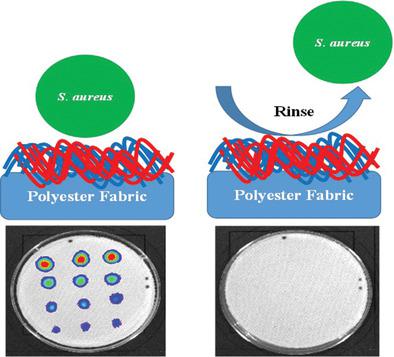当前位置:
X-MOL 学术
›
Macromol. Mater. Eng.
›
论文详情
Our official English website, www.x-mol.net, welcomes your
feedback! (Note: you will need to create a separate account there.)
Polyelectrolyte Complex that Minimizes Bacterial Adhesion to Polyester
Macromolecular Materials and Engineering ( IF 4.2 ) Pub Date : 2021-09-02 , DOI: 10.1002/mame.202100579 Ryan J. Smith 1 , Madeleine G. Moule 2 , Pablo A. Leon 3 , Ethan T. Iverson 1 , Thomas J. Kolibaba 3 , Jeffrey D. Cirillo 4 , Jaime C. Grunlan 1, 3
Macromolecular Materials and Engineering ( IF 4.2 ) Pub Date : 2021-09-02 , DOI: 10.1002/mame.202100579 Ryan J. Smith 1 , Madeleine G. Moule 2 , Pablo A. Leon 3 , Ethan T. Iverson 1 , Thomas J. Kolibaba 3 , Jeffrey D. Cirillo 4 , Jaime C. Grunlan 1, 3
Affiliation

|
Bacterial adhesion is a major concern in the medical field, where bacterial fouling can lead to diminished device efficacy and failure. To combat this, polyelectrolyte complexes (PECs) can be used to modify surfaces to reduce bacterial attachment. In the present study, a water-based PEC of poly(diallyldimethylammonium chloride) [PDDA] and poly(acrylic acid) are deposited in a simple two-step process to the surface of polyester fabric. This process includes the deposition of a dissolved mixture of the two polyelectrolytes, followed by the formation of the ionic network through exposure to citric acid buffer. These coatings facilitate the removal of >95% of deposited Staphylococcus aureus after simple rinsing with deionized water. The high degree of surface ionization monitored by FTIR suggests that electrostatic repulsion is responsible for the observed antifouling activity. The morphology of these coatings which is monitored by scanning electron microscope (SEM) and atomic force microscope (AFM) is shown to depend on curing the curing conditions, which suggests that this simple process can be tailored to many applications.
中文翻译:

最大限度减少细菌对聚酯的粘附的聚电解质复合物
细菌粘附是医疗领域的一个主要问题,其中细菌污染会导致设备功效降低和故障。为了解决这个问题,聚电解质复合物 (PEC) 可用于修饰表面以减少细菌附着。在本研究中,聚(二烯丙基二甲基氯化铵)[PDDA] 和聚(丙烯酸)的水性 PEC 通过简单的两步工艺沉积到聚酯织物表面。该过程包括两种聚电解质的溶解混合物的沉积,然后通过暴露于柠檬酸缓冲液形成离子网络。这些涂层有助于去除 > 95% 的沉积金黄色葡萄球菌用去离子水简单冲洗后。FTIR 监测到的高度表面电离表明静电排斥是观察到的防污活性的原因。通过扫描电子显微镜 (SEM) 和原子力显微镜 (AFM) 监测的这些涂层的形态表明取决于固化条件,这表明这种简单的过程可以适应许多应用。
更新日期:2021-09-02
中文翻译:

最大限度减少细菌对聚酯的粘附的聚电解质复合物
细菌粘附是医疗领域的一个主要问题,其中细菌污染会导致设备功效降低和故障。为了解决这个问题,聚电解质复合物 (PEC) 可用于修饰表面以减少细菌附着。在本研究中,聚(二烯丙基二甲基氯化铵)[PDDA] 和聚(丙烯酸)的水性 PEC 通过简单的两步工艺沉积到聚酯织物表面。该过程包括两种聚电解质的溶解混合物的沉积,然后通过暴露于柠檬酸缓冲液形成离子网络。这些涂层有助于去除 > 95% 的沉积金黄色葡萄球菌用去离子水简单冲洗后。FTIR 监测到的高度表面电离表明静电排斥是观察到的防污活性的原因。通过扫描电子显微镜 (SEM) 和原子力显微镜 (AFM) 监测的这些涂层的形态表明取决于固化条件,这表明这种简单的过程可以适应许多应用。











































 京公网安备 11010802027423号
京公网安备 11010802027423号